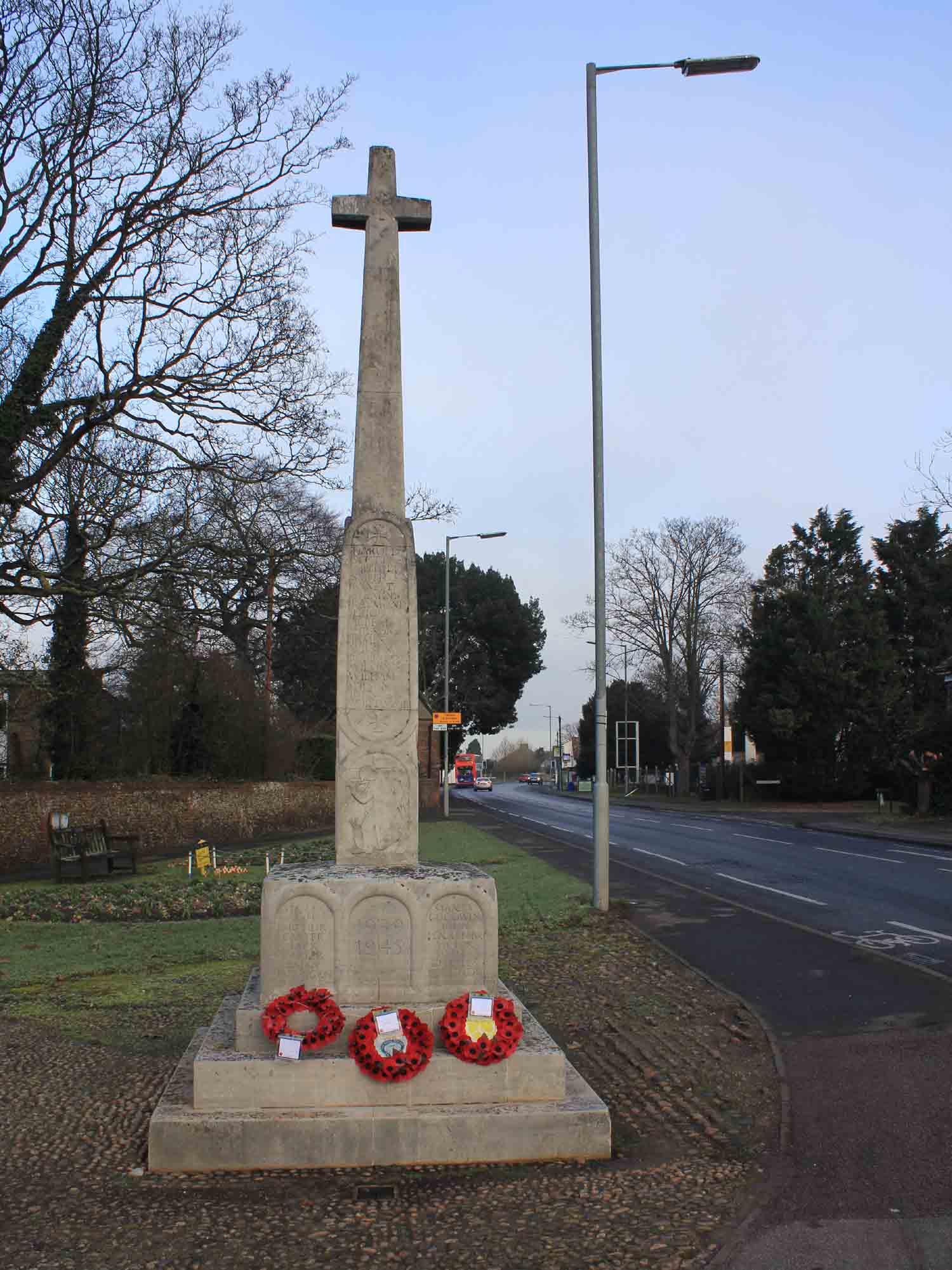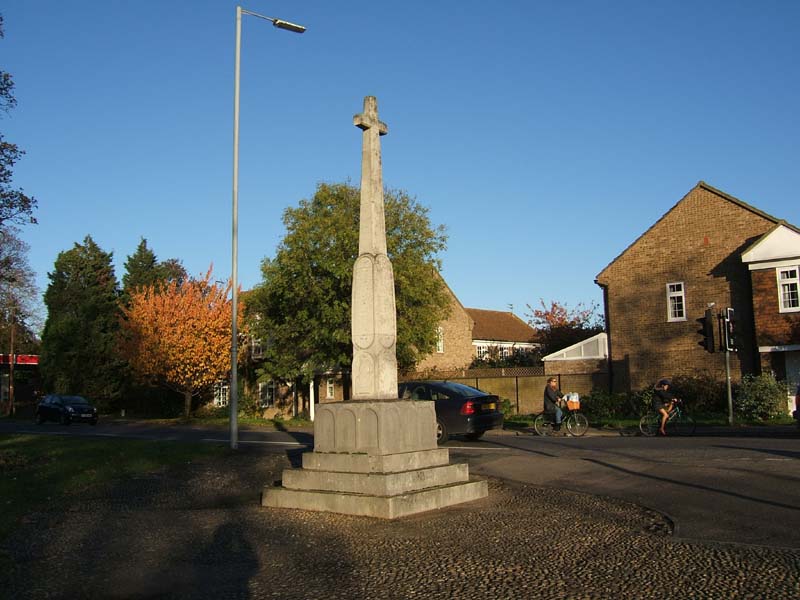Trumpington War Memorial on:
[Wikipedia]
[Google]
[Amazon]


 Trumpington War Memorial is a
Trumpington War Memorial is a
Trumpington War Memorial
Historic England
War Memorials Online
roll-of-honour.com
Trumpington Local History Group
Trumpington Local History Group
Trumpington Local History Group
''The Great War and Medieval Memory: War, Remembrance and Medievalism in Britain and Germany, 1914-1940''
Stefan Goebel, Cambridge University Press, 2007, , p. 60-61
{{coord, 52.1754, N, 0.1126, E, source:wikidata, display=title Grade II* listed monuments and memorials Grade II* listed buildings in Cambridgeshire Buildings and structures completed in 1921 World War I memorials in England World War II memorials in England Monuments and memorials in Cambridgeshire


 Trumpington War Memorial is a
Trumpington War Memorial is a war memorial
A war memorial is a building, monument, statue, or other edifice to celebrate a war or victory, or (predominating in modern times) to commemorate those who died or were injured in a war.
Symbolism
Historical usage
It has ...
cross in the village of Trumpington
Trumpington is a village and parish to the south of Cambridge, England. The village is an electoral ward of the City of Cambridge and a ward of South Cambridgeshire District Council. The 2011 Census recorded the ward's population as 8,034.
T ...
, on the southern outskirts of Cambridge
Cambridge ( ) is a College town, university city and the county town in Cambridgeshire, England. It is located on the River Cam approximately north of London. As of the 2021 United Kingdom census, the population of Cambridge was 145,700. Cam ...
. The memorial was designed by Eric Gill
Arthur Eric Rowton Gill, (22 February 1882 – 17 November 1940) was an English sculptor, letter cutter, typeface designer, and printmaker. Although the ''Oxford Dictionary of National Biography'' describes Gill as ″the greatest artist-cra ...
. It was unveiled in 1921, and became a Grade II* listed building
In the United Kingdom, a listed building or listed structure is one that has been placed on one of the four statutory lists maintained by Historic England in England, Historic Environment Scotland in Scotland, in Wales, and the Northern Irel ...
in 1999.
Proposals for a war memorial were considered by a sub-committee of the Trumpington parish council in May 1919; members included the parish priest, Rev. Arthur Christopher Moule (former Professor of Chinese at Cambridge University, and son of Bishop George Moule), and the medical doctor William Warburton Wingate (husband of Viola Pemberton, whose family owned Trumpington Hall). Options considered included a memorial garden with tennis courts, a clock tower, and an obelisk, but the committee selected a memorial cross. The cost of the memorial was raised by public subscription, with the Pemberton family contributing £200. Eric Gill
Arthur Eric Rowton Gill, (22 February 1882 – 17 November 1940) was an English sculptor, letter cutter, typeface designer, and printmaker. Although the ''Oxford Dictionary of National Biography'' describes Gill as ″the greatest artist-cra ...
was commissioned to make the cross. He had already carved the inscription for a memorial for a member of the Pemberton family at the parish church of St Mary and St Michael nearby.
The memorial is located at a site in the centre of the village, formerly called Cross Hill, at the junction of the High Street, and Church Lane which leads towards the church, becoming Grantchester Road and continuing west towards Grantchester
Grantchester is a village and civil parish on the River Cam or Granta in South Cambridgeshire, England. It lies about south of Cambridge.
Name
The village of Grantchester is listed in the 1086 Domesday Book as ''Grantesete'' and ''Graunts ...
. Originally the cross was located in the road to Grantchester, with the carriageway passing to either side; now it is surrounded by a paved area, with the road passing to the south. During construction, excavation works for the foundations uncovered a large square Barnack stone
Barnack is a village and civil parish, now in the Peterborough unitary authority of the ceremonial county of Cambridgeshire, England and the historic county of Northamptonshire. Barnack is in the north-west of the unitary authority, south-east ...
with a socket, inscribed in memory of John Stockton and his wife Agnes; the stone is believed to be the 13th-century base for a wooden roadside cross, and it is now preserved inside the church.
The memorial is built from Portland stone. It comprises a Latin cross
A Latin cross or ''crux immissa'' is a type of cross in which the vertical beam sticks above the crossbeam, with the three upper arms either equally long or with the vertical topmost arm shorter than the two horizontal arms, and always with a mu ...
standing on a square plinth, itself standing on a square base of three steps.
Each of the four sides of the cross shaft bears two carved and inscribed panels. The lower round-headed panels have high-relief images representing the parish's two patron saints - the Virgin Mary
Mary; arc, ܡܪܝܡ, translit=Mariam; ar, مريم, translit=Maryam; grc, Μαρία, translit=María; la, Maria; cop, Ⲙⲁⲣⲓⲁ, translit=Maria was a first-century Jewish woman of Nazareth, the wife of Joseph and the mother of ...
(on the west side, with a baby and cradle) and Saint Michael
Michael (; he, מִיכָאֵל, lit=Who is like El od, translit=Mīḵāʾēl; el, Μιχαήλ, translit=Mikhaḗl; la, Michahel; ar, ميخائيل ، مِيكَالَ ، ميكائيل, translit=Mīkāʾīl, Mīkāl, Mīkhāʾīl), also ...
(on the north side, with wings, slaying a dragon) - and also the patron saint of England Saint George
Saint George (Greek: Γεώργιος (Geórgios), Latin: Georgius, Arabic: القديس جرجس; died 23 April 303), also George of Lydda, was a Christian who is venerated as a saint in Christianity. According to tradition he was a soldie ...
(on the east side, accompanied by a human figure, also slaying a dragon), with the fourth panel to the south showing a tired soldier (this panel based on a David Jones design). The upper panels are elongated ovals, each inscribed with nine names commemorating the 36 men from the village killed in the First World War, with small crosses at the top and bottom.
The four sides of the plinth are decorated with three carved round-headed arches. The east side, towards the High Street, bears the dates "1914" and "1918" in the side arches, with an inscription in the centre arch: "MEN / OF TRUM- / PINGTON / WHO GAVE / THEIR LIVES / IN THE / GREAT / WAR". The south side, towards Church Lane, has the inscribed dates "1939–1945" in the central arch, with the names of 8 war dead from the Second World War in the two side arches (inscriptions added later, probably by David Kindersley
David Guy Barnabas Kindersley MBE (11 June 1915 – 2 February 1995) was a British stone letter-carver and typeface designer, and the founder of the Kindersley Workshop (later the Cardozo Kindersley Workshop). His carved plaques and inscription ...
). The west side bears the inscription "FOR / LIBERTY / AND / JUSTICE'" in the centre arch, with the ones to either side blank. The arches to the north side bear no inscriptions.
The memorial was unveiled on Sunday 11 December 1921, with a service at the parish church nearby by Rev. Moule. It was renovated in 2014 when a further Second World War name, Lieutenant Jack Neville Creek (Argyll and Sutherland Highlanders) was added.
See also
*Grade II* listed war memorials in England
There are 137 Grade II* listed war memorials in England, out of over 4,000 listed war memorials. In the United Kingdom, a listed building is a building or structure of special historical or architectural importance; listing offers the building ...
*John Pendlebury
John Devitt Stringfellow Pendlebury (12 October 1904 – 22 May 1941) was a British archaeologist who worked for British intelligence during World War II. He was captured and summarily executed by German troops during the Battle of Crete.
...
, named among the dead from the Second World War
References
Trumpington War Memorial
Historic England
War Memorials Online
roll-of-honour.com
Trumpington Local History Group
Trumpington Local History Group
Trumpington Local History Group
''The Great War and Medieval Memory: War, Remembrance and Medievalism in Britain and Germany, 1914-1940''
Stefan Goebel, Cambridge University Press, 2007, , p. 60-61
External links
{{coord, 52.1754, N, 0.1126, E, source:wikidata, display=title Grade II* listed monuments and memorials Grade II* listed buildings in Cambridgeshire Buildings and structures completed in 1921 World War I memorials in England World War II memorials in England Monuments and memorials in Cambridgeshire